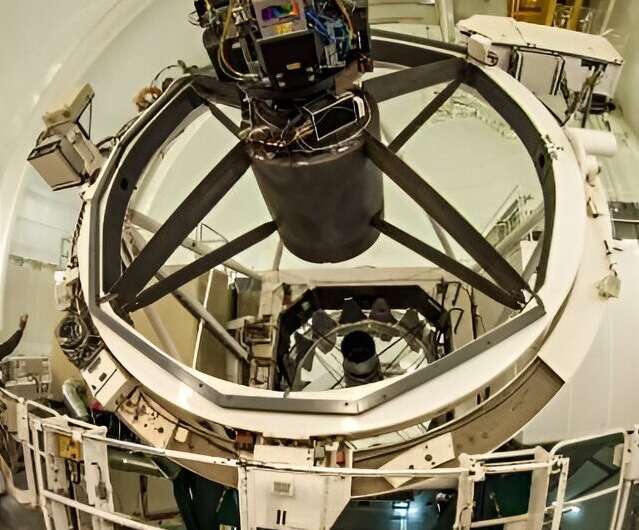
The PAUcam camera is installed at the main focal point of the William Herschel Telescope (WHT) in La Palma, Spain. Credit: PAUS team
The Physics of the Accelerating Universe Survey (PAUS), an international collaboration among 14 institutions, has covered 50 square degrees of sky, equivalent to about 250 full moons.
Using the PAUCam camera on the 4.2-meter William Herschel Telescope (WHT) in La Palma, Spain, it was able to determine the distances of galaxies with unprecedented precision. This includes galaxies more than 10 billion light years away.
Surveys of distant galaxies are carried out in two ways: photometric surveys, which take high-resolution images of the sky and capture all astronomical objects that are bright enough to be discernible in those images, and spectroscopic surveys, which identify a source of light. target and study it. Spectrum, that is, the distribution of its light in a wide range of wavelengths.
This mode is limited in the number of observable galaxies and how dim they are, but provides a lot of information about each galaxy.
Associate member Professor Benjamin Joachim, from UCL’s Department of Physics and Astronomy, explained that PAUS “combines the advantages of photometric and spectroscopic surveys.”
He said: “We take pictures and therefore all visible objects in the sky, but we do this by putting narrow wavelength filters on the camera so that we know the light we are collecting is coming from a specific part of the spectrum. Using 40 of these filters, we can reconstruct a low-resolution version of the galaxy.
“This survey will allow us to discover how galaxies are bound to their environment, which is mainly made up of dark matter, and to understand how far away galaxies of a certain type and brightness are, which will help us with the survey. Those who don’t, let’s do a more detailed science.”
The new catalog will enable astronomers to create more detailed maps to understand how structure forms in the universe and to study the expansion of the universe under the influence of dark matter and dark energy.
Dark energy is thought to make up about 70% of the universe and is responsible for the universe’s accelerated expansion, but its nature remains a mystery.
The collaboration was led by the Institute of Space Sciences (ICE-CSIC), supported by the Spanish Ministry of Science, Innovation and Universities. Data was collected over 200 nights between 2015 and 2019. This catalog is available on PAUS website and CosmoHub web portal.
Professor Enrique Gaztanaga, director of the PAU survey based at the University of Portsmouth, ICE-CSIC and the Institute for Space Studies of Catalonia (IEEC), said: “PAU research offers a pioneering approach to the creation of cosmic maps made possible by these maps. It has been a privilege to work with such a talented and reliable group to design and develop a new tool and a dedicated survey to collect and analyze data in a way that has never been done before.
The publication of the catalog is detailed in two articles. One is published on the calibration of PAUS data Monthly Notices of the Royal Astronomical Society. another, on the measurement of distances, to be published by MNRAS and is available arXiv Preprint server
David Navarro-Girones, Ph.D. ICE-CSIC student and first author of the book arXiv The article said, “The great advantage of PAUS is that…[allows] “For very precise distance measurements, this level of precision is critical to studying the structure of the universe, which in turn requires data from a large number of galaxies.”
Nine years after its first light in 2015, PAUS is able to measure the distances of numerous distant galaxies with a relative precision of 0.3 percent. The team is currently using these data to improve the calibration of existing cosmological surveys.
For example, PAUS data will be used to improve weak lensing analyzes and simulations for dark energy missions such as the European Space Agency’s Euclid mission, whose Massive Optical Camera was built by an international team led by UCL researchers, and the Rubin Observatory Legacy Survey. Space and Time (LSST).
More information:
FJ Castander et al., Review of PAU: photometric calibration of narrowband images, Monthly Notices of the Royal Astronomical Society (2024). DOI: 10.1093/mnras/stae1507
David Navarro-Girones et al., PAU Review: Photometric Redshift Estimation in Deep Wide Fields, Monthly Notices of the Royal Astronomical Society (2024). DOI: 10.1093/mnras/stae1686. bright arXiv: DOI: 10.48550/arxiv.2312.07581
Presented by University College London
quote: Precise locations of over 1 million galaxies revealed (2024, September 28) Retrieved September 29, 2024, from https://phys.org/news/2024-09-precise-million-galaxies-revealed.html.
This document is subject to copyright. Except for any fair dealing for the purpose of private study or research, no part may be reproduced without written permission. Content is provided for informational purposes only.
#Exact #locations #million #galaxies #revealed